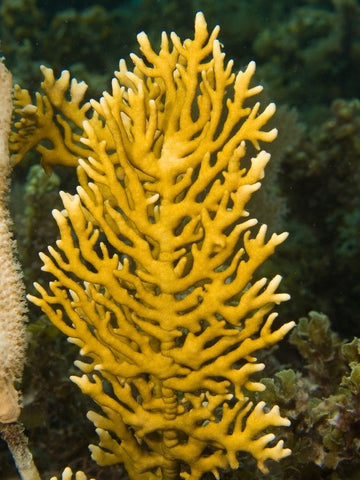TOP 5 THINGS YOU SHOULD BE ABLE TO IDENTIFY IF YOU LIVE IN SOUTH FLORIDA

Water Edition
1. Fire Coral
Being an avid diver puts this at the top of my list. While it won’t kill you, Fire Coral can be very painful if you come into contact with it. Touching it WILL make your skin feel like it’s burning. It grows where most corals grow- sometimes in even more shallow waters and deeper than you might expect. It can be easily spotted due to its orange/red color, but only at well-lit depths. Remember, after five meters depth you will no longer be able to see the color red without supplemental light. Fire Coral can be fingering (branching), bladed (flat but still growing upright), or encrusting (covers the surface it is growing on). It is not very picky about where it lives. When doing maintenance on the coral trees in Bonaire, many of us were stung by the encrusting Fire Coral on the branches that held our coral fragments. If you do find yourself stung, vinegar is said to alleviate the stinging and itching. Personally, it does not work for me. Instead, I opt to grab a handful of sand and scrub out the microscopic barbs. Either way, the stinging should subside quickly if you didn’t touch too much of it. Fire Coral has tiny polyps that are equipped with venomous barbs, the same way a jellyfish’s tentacles are (corals and jellyfish are both in the phylum Cnidaria). While it is usually harmful to the corals to be touched, this coral can harm you.

Branching fire coral.

Encrusting and bladed fire coral; Bonaire.
2. Lionfish
Looks like a great aquarium pet, right? That’s exactly what someone else thought…until it ate all the other fish. The exotic pet trade is responsible for almost all of the invasive species found in South Florida today. People think they know what they’re getting, but when they are dissatisfied, they simply release the animal where it doesn’t belong. For example, the Lionfish. Beautiful, with its red and white stripe, but this fish is highly venomous. If you are stung, the swelling and pain can last for days, and even cause paralysis. The Lionfish’s spines contain a potent neurotoxin that is still active after death. For those that want to hunt and prepare their own Lionfish, do so with thick gloves and RESEARCH the proper techniques to safely fillet. It is recommended you seek medical attention immediately, but the official treatment is hot water. That being said, the water should not be above 115 degrees Fahrenheit. Then you’ll have burns and a Lionfish sting to worry about. Lionfish are extremely invasive; they have decimated many important reef populations and make it incredibly difficult for species to recover. Hunting them for your Friday night fish fry is the best thing you can do for the reefs, but if you cannot do it safely, you shouldn’t attempt it at all.

Lionfish displaying its spines; Bonaire.
3. Jellyfish (Some Hurt More Than Others)
My least favorite animal in the whole ocean. Personal bias aside, there are a few types you should know. The one you will likely have the most encounters with - especially if you love going to the beach - is sea lice. It’s not as bad as it sounds. While they WILL cause uncomfortable burning and maybe itching, they are not actually lice! Sea lice are just tiny jellyfish babies that get stressed out when they get stuck in your swimsuit; that’s when the stinging occurs. Now, we’ve all heard that peeing stops the sting. PLEASE don’t pee on your friend! There are MANY various brands of sting relief (usually in gel form), and I give my personal guarantee that they are much more effective - also less embarrassing - than urine. Next up is the comb jelly. These little guys can’t do anything to you, even though they are jellyfish. So, if you’ve always wanted to know what those brainless, eyeless, and boneless little blobs felt like, you can touch comb jellies all you want. I don’t like ANY jellyfish so I kept a minimum six-foot distance before it was cool. Moon jellies and Cassiopeia’s are two other jellies you’ll interact a lot with in South Florida. While moon jellies can be found virtually anywhere (including your face, as my divemaster once had the pleasure of experiencing), Cassiopeia’s stick to the ground. Literally. These filter feeders rest upside down in seagrass beds; usually in shallow water. While it won’t hurt terribly (either one of you) if you step on one, you should still avoid it. Moon jellies hurt about the same as sea lice. My final jellyfish (actually it is a siphonophore, a close relative) is, unfortunately, not so forgiving in its encounters. The Portuguese Man o’ War is not to be trifled with. Depending on the situation, the situation can be mild or life-threatening. Like any jellyfish sting, new studies by the University of Hawaii at Manoa and the National University of Ireland in Galway have found that you can also treat Man o’ War stings with vinegar and mild warmth. Be very careful when performing any sort of rinse over a jellyfish sting, as you can end up spreading the stinging cells (nematocysts) over a larger area. Just like lionfish, Man o’ Wars can sting even in death; so be careful if you see one in the sand.
Author’s Note: This is why you should reuse plastic bags as much as possible, don’t use a plastic straw if you don’t need it, and cut your six-pack rings before throwing them away - I need turtles to stay alive and healthy so they can continue eating jellyfish!

Sea lice (larvae)

Comb Jelly

Moon Jellyfish

Cassiopeia Jellyfish

Portuguese Man o’ War
4. Staghorn/Elkhorn Coral
Don’t worry, these can’t hurt you. Why are they on the list, then? Reefs all over the world are under siege from rising ocean temperatures and acidification; especially in South Florida, which boasts one of the largest barrier reef systems. I’ve done lots of restoration work on these two species in particular, and they really are magnificent. Both of these hard corals (meaning, they leave behind a limestone skeleton) look similar to their namesake, making them easily identifiable. The next time you are visiting a reef, look for one or both. Seeing an abundance of these two corals means the reef is extremely healthy: there will be lots of fish hiding in the ‘thickets’ of staghorn coral. However, if you don’t see them, it doesn’t necessarily mean the reef is unhealthy or dying. Staghorn and elkhorn grow in relatively shallow waters. If you are on a wreck or a wall; you may not encounter these two corals, and it’s okay!


Staghorn Coral, Bonaire (Photos: Lizzie)


Elkhorn Coral
5. Crocodile vs. Alligator
This one is easier than it sounds AND will give you some brownie points. First, alligators and crocodiles rarely inhabit the same area. Crocodiles can move from freshwater to saltwater, while alligators stick to freshwater. The closer you are to the ocean, the more likely you’re looking at a croc. Next, their snouts are different. Alligators have a very round snout, while crocodiles have sharp taper. Their overall color is also a good indicator; alligators are much darker than the crocodiles’ olive hue. While both can be dangerous, alligators are said to be more aggressive and territorial than crocodiles. After mating season, when females are guarding their nests, it’s best not to go near either one. Both alligators and crocodiles will hiss to warn you away. This hiss is loud and clearly heard. You will immediately know when you have made Mama angry. Another difference is their teeth. Crocs show off nearly all of their teeth when their mouth is closed, while alligators only sport their upper teeth. Hopefully, you’ll never be in a situation where you have to resort to this method. In any case, the shape of their snouts and overall color will be your best bet.

American Alligator

Saltwater Crocodile
Articles and publications of other companies:
- +1 (305) 887-0301
- 10209 Northwest 116th Way, Medley, Miami-Dade, FL 33178, US
- www.shakakai.com/


